This was published 8 months ago
‘An overnight success 20 years in the making’: The rise of Kamala Harris
The transformation of attitudes towards Kamala Harris since she announced her run for the US presidency has been rapid and profound. Was she underestimated or has she changed – and will it be enough to win her the White House?
By Nick Bryant
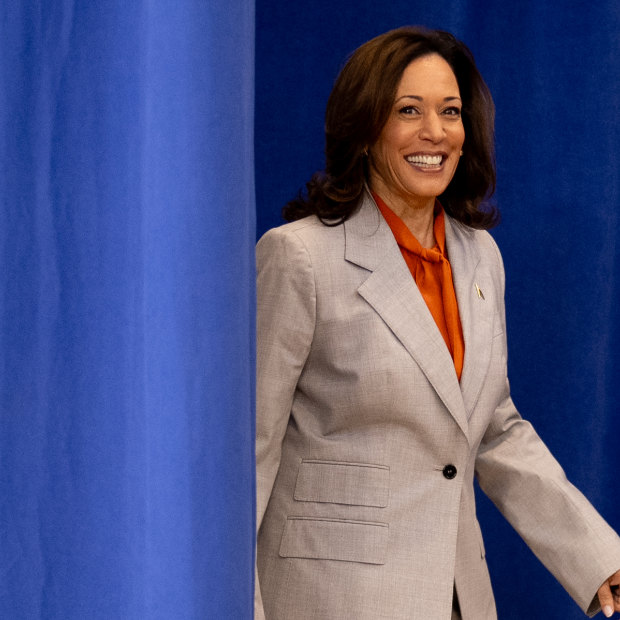
Of Harris, it was sometimes said she was famous and yet unknown. Voters could not make sense of her. She was opaque. So would she be relatable enough? Would she be “likeable” enough, that sexist trope so often deployed against ambitious female candidates? Credit: Getty Images
When the most important phone call of her life came through, Kamala Harris was cooking up pancakes and bacon for her two baby nieces – the kind of all-American recreation that might shock voters warned by Donald Trump that she’s a radical Marxist feminist who poses a threat to their way of life. “Crazy Kamala” “Laffin’ Kamala,” “Lyin’ Kamala,” and “Kamabla,” he has labelled her, flailing around for a playground taunt that sticks.
That Sunday morning, US President Joe Biden was holed up at his Delaware holiday home recovering from his third bout of COVID-19. But it was the fevered mood of his party, and his mounting political isolation, that prompted him to contact the vice president’s residence in Washington, his one-time home. Reluctantly – tortuously – Biden had decided to withdraw from the race for the White House, thus becoming the first president not to seek re-election in more than half a century. “Are you sure?” the vice president replied. “Yes,” she recalls him responding.
From the moment in late June when the 81-year-old president shuffled onto the debate stage to take on Donald Trump, his arm movements near robotic, his colourless face looking like it had already been embalmed, a panic had set in among Democrats. Biden could scarcely string a sentence together. So whispery was his delivery that talking points were barely audible. At times, he could not summon words. A train wreck. A disaster. A calamity. Worst. Debate. Performance. Ever. WTF. Just the shimmer of flop sweat on Richard Nixon’s upper lip, when the then vice president took part in the first ever televised debate against John F. Kennedy, was thought to have lost him the 1960 presidential election. Biden was haemorrhaging blood.
So even before the debate had concluded, senior Democrats frantically canvassed the names of substitute candidates. The California governor, Gavin Newsom, was the kind of super-confident, telegenic politician who could go toe-to-toe with Trump. Gretchen Whitmer, the governor of Michigan, had proven a woman could prosper in the Rust Belt. Governor Josh Shapiro, from the must-win battleground state of Pennsylvania, was such an eloquent orator that he sounded uncannily like Barack Obama. Critics have accused him of mimicry.
Any list of alternatives plainly had to include Kamala Harris. As vice president, ordinarily she would be next in line. But a question which had been in the back of Democrats’ minds for the previous three-and-a-half years now loomed in the forefront: would she do any better than Biden? Some fretted she would fare even worse.
The 59-year-old vice president wasn’t a great communicator, it was widely thought. She said weird things – something odd about falling out of a coconut tree that went viral. She kept on repeating a catchphrase which sounded like treacly desk-calendar wisdom: “What can be, unburdened by what has been.” Her laugh was deemed off-putting. So, too, her voice. She was a Californian, and no West Coast Democrat had ever won the presidency, partly because they are so easily caricatured as bi-coastal elitists: limousine liberals who view the Middle American “fly-over states” with disdain.
Of Harris, it was sometimes said she was famous and yet unknown. Voters could not make sense of her. She was opaque. So would she be relatable enough? Would she be “likeable” enough, that sexist trope so often deployed against ambitious female candidates? Would America countenance a female president? Could a black woman of Indian and Jamaican descent beat a white “America First” nationalist?
Despite the number of times conventional wisdom has been proven wrong-headed – Trump could never win in 2016, Biden was too old in 2020 – received opinion still steers the hive-mind of Washington DC. And the prevailing thinking about Harris was that she would make a lousy candidate. A prime reason why Biden decided to seek re-election in the first place was the belief he was better placed to beat Trump than his deputy, especially in the all-important Rust Belt.
Yet as the smell of bacon wafted through the vice-presidential mansion on that Sunday morning, here was the president not only informing her of his withdrawal from the race but handing her the torch. Twenty-seven minutes after announcing to the world that he was stepping aside, Biden issued a follow-up statement pledging his “full support and endorsement” of Harris. Then, at warp speed, the party rallied around. We were witnessing the transfer of power from Joe Biden, and the transformation, in the public mind at least, of Kamala Harris. Soon after, as she closed that gap in the polls that Trump had opened up over Biden, she was offering proof of her mantra: “What can be, unburdened by what has been.”
The storyline early in her career was altogether more glowing. Kamala Harris was a proven winner unafraid of fighting battles she seemed bound to lose. A badass prosecutor whose favourite curse, by her own admission, is “motherf---er”.
Her combative spirit came from her Indian-born mother Shyamala, a dynamo of a woman who taught Kamala about the Hindu goddess Kali, a mythic warrior who decapitated demons. Her political boot camp was the Bay Area in northern California, full of Democrats who decapitated fellow Democrats. Though often thought of as a haven of flower-power ’60s radicalism, San Francisco and her home city of Oakland have produced a string of hard-nosed pols. Nancy Pelosi, the first female House speaker, renowned, as her daughter once put it, for chopping off opponents’ heads without them even realising they were bleeding. Gavin Newsom. The late senator Dianne Feinstein, who was such a wily politician that she died in office, aged 90. From this fight club, Harris also graduated.
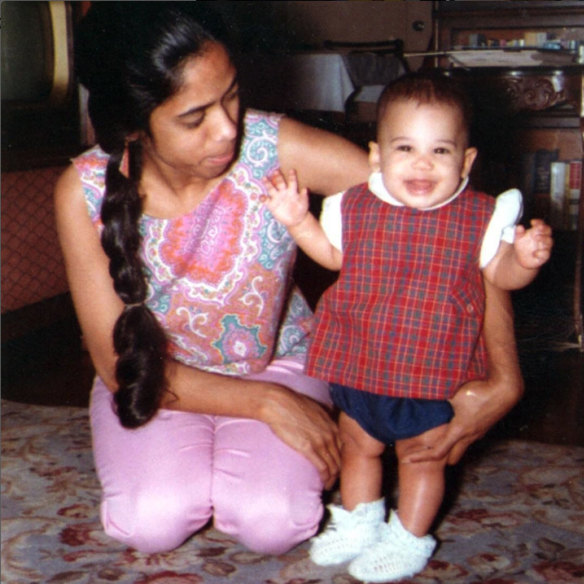
With her mother Shyamala, who taught Harris about the Hindu goddess Kali, who decapitated demons.Credit: @vp/Instagram
The young prosecutor was also a protégé – and one-time girlfriend – of an old-style machine boss, Willie Brown, the flamboyant former speaker of the California assembly and mayor of San Francisco who was known as something of a kingmaker. “These are world-class politicians,” says Harris’s biographer, Dan Morain, the author of Kamala’s Way: An American Life, the 2021 book which chronicles her fast ascent. “Politicians who come from San Francisco have moves that other politicians don’t have.”
Harris’ signature move, in the early years of her political career, was giant-killing. In her first run for office, when in 2003 she entered the race for the district attorneyship of San Francisco, her incumbent opponent was her former boss Terence Hallinan, a Democratic luminary whose father had sought the presidency in the early 1950s as the standard-bearer of the Progressive Party. Harris beat him 56 per cent to 44 per cent.
Seven years later, when she ran for state attorney-general, California’s leading law enforcement official, Harris felled another towering figure. Her opponent, the Republican Steve Cooley, a popular three-term district attorney from Los Angeles, even declared himself the winner on election night. Yet three weeks later, after postal ballots had been tallied, Harris won a nail-biting victory by less than 0.85 per cent of the vote.
Earmarked as a rising star, she was labelled “the female Barack Obama” by one of the country’s most prominent African-American journalists, Gwen Ifill of PBS Newshour. And it was Obama who, inadvertently, brought her to national attention. At a Democratic fundraiser in 2013, the then-president called his long-time friend “brilliant”, “dedicated” and “tough”. Then, his flattery lapsed into sexism: “She also happens to be, by far, the best-looking attorney-general in the country.” When Obama afterwards called her to apologise, coverage was wall-to-wall. Now she had that most valuable of political assets: name recognition.
Her unbroken winning streak continued when, in 2016, she set her sights on Washington, following the retirement of one of California’s Democratic senators, another Bay Area politician, Barbara Boxer. Under California’s idiosyncratic electoral system, she was pitted against a fellow Democrat rather than a Republican in that November’s run-off and won in a landslide. Now it was possible to speak of “Harris’s way”, according to Dan Morain, who followed her career from his perch at the Sacramento Bee. To “enter the race early, show strength” and “thin the field”. Victory, however, was bittersweet. She won the night that Hillary Clinton suffered her shock defeat. president-elect Donald J. Trump was also on his way to Washington.
Harris’ arrival on Capitol Hill polished her reputation for humbling over-confident men. Trump’s new attorney-general, Jeff Sessions, was reduced to a trembling weakling when Harris quizzed him about alleged collusion between the Trump campaign and the Kremlin to swing the 2016 election. “I’m not able to be rushed this fast,” said the Alabaman, the jitters discernible in his cornpone voice: “It makes me nervous.” During the 2018 confirmation hearings for Trump’s controversial Supreme Court nominee, Brett Kavanaugh – as much a cultural as a political event – she became a breakout star. As Kavanaugh repeatedly sidestepped questions about his opinion of the abortion ruling Roe v. Wade, she probed further: “Can you think of any laws that give the government the power to make decisions about the male body?” – a question he was unable to answer. Even if she could not boast the lyricism of Obama, she certainly had a gift for making conservatives squirm.
Expectations, then, ran high when she entered the 2020 presidential race, which pitted her against better-known figures such as Biden and Senator Bernie Sanders. Everyone agreed she started well, with a campaign launch attracting 20,000 supporters in Oakland and a stump speech built around an uplifting story of immigrant success. Even Trump, that aficionado of crowd size, was impressed, calling it “the best opening so far”.

From left: First Lady Jill Biden, President Joe Biden, Vice President Kamala Harris and Second Gentleman Doug Emhoff at a 2022 Christmas tree lighting,Credit: Getty Images
Harris was also crowned winner of the first televised debate with her Democratic rivals, after carrying out something of a drive-by shooting on Biden. In the early 1970s, the then-senator opposed the policy of federal busing, which transported black children to predominantly white schools as a means of desegregating them. After describing how one small child in California had benefited from being driven across town, she then delivered the wounding line: “That little girl was me.”
‘There are very few people she is prepared to be herself around; she is overcautious about how she presents herself.’
Courtney Subramanian
The clash with Biden proved the high-water mark of her campaign. Thereafter, Harris lost her way. Her campaign, overseen by her younger sister Maya, was riven with factionalism. She struggled to articulate why she was seeking the presidency. At a time when Democrats had reacted to the extremism of Trumpism by lurching further to the left, Harris’s pragmatic centrism was no longer in vogue. Her espousal of left-wing positions, moreover, sounded inauthentic. As one Democratic strategist told me, “She was trying to out-Bernie Bernie Sanders.” In late 2019, even before a single vote was cast in the Iowa caucus or New Hampshire primary, she dropped out of the contest. Her campaign had run out of money, the mother’s milk of US politics. Months later, Biden emerged as the nominee.
“Not yet ready for prime time” was the view of the campaign press corps. Nor was she comfortable with the soul-sharing requirements of a presidential run: the willingness to emotionally bare all. “She’s fiercely private,” says Courtney Subramanian, a former White House correspondent for USA Today and the Los Angeles Times, now working for the BBC, who has covered Harris closely. “There are very few people she is prepared to be herself around, and she is overcautious about how she presents herself. Ultimately, it sinks her.”

With US journalist Courtney Subramanian, who says the vice president is “fiercely private”.Credit: Los Angeles Times via Getty Images
Given that the presidency had been the target of Harris’s ambition, she did not lobby the Biden team when it vetted prospective vice-presidential candidates. The Democrats, however, needed a woman to balance the ticket. Then, midway through 2020, after a policeman murdered the African-American George Floyd, selecting a woman of colour became imperative. Biden was untroubled by Harris’s debate attack, and asked her to be his running mate. “Biden’s a pro,” says Dan Morain. “He knew she was not running for second place.” His wife Jill Biden, though, was less forgiving. Describing the attack as “a punch to the gut”, she carried a grievance for years.
Biden’s victory over Trump in the 2020 election put Harris a heartbeat away from the presidency, and the cardiovascular system of America’s oldest-ever president was unlikely to get any stronger. So when he was sworn in as the country’s 46th president – I watched from the press riser a few yards away – we inevitably wondered, as Harris took her oath as deputy, whether we were also in the presence of the 47th. Biden, after all, had spoken of himself “as a bridge” to the next generation of Democratic leaders. Harris, he intimated, was his heir.
On entering the White House, however, it looked from the outside as if Biden was setting her up to fail. To his vice president, he handed the trickiest of portfolios: a key role in sorting out the chaos at America’s southern border with Mexico. Tasked with tackling the “root causes” of the problem, Harris spearheaded diplomatic efforts in the so-called “northern triangle” Central America countries of Guatemala, Honduras and El Salvador. Though given no operational role in handling the border itself, she became the face of the administration’s “do not come” policy aimed at deterring prospective immigrants at source.
Biden, when he served as vice president, had been given a similar assignment by Barack Obama, but border politics were nowhere near as incendiary back then. Harris, as a result, came under closer scrutiny. So when in June 2021 she made her first foreign trip on Air Force Two, which included a stop in Guatemala, she was trailed by one of America’s leading news anchors, NBC’s Lester Holt. Their sit-down interview was a car crash. Holt pressed her on why she had not visited the southern border. “We’ve been to the border,” she protested, which was a blatant falsehood.
“You haven’t been to the border,” Holt shot back.
“And I haven’t been to Europe,” she added, a non sequitur that took flight online. Her Republican enemies pounced. Dubbing her a failed “border csar”, a label which exaggerated her limited role, they demanded she be relieved of her duties. Afterwards, Harris stopped doing interviews, and became more wary of the press.
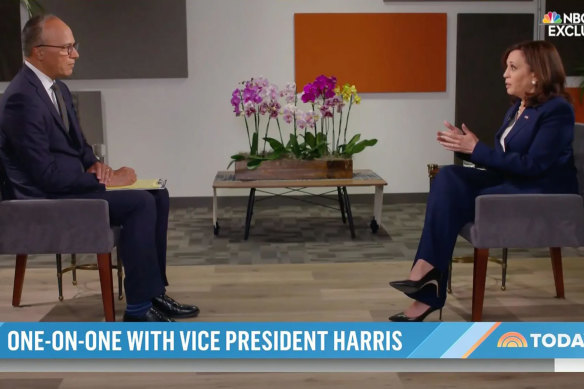
After an awkward 2021 interview with NBC news anchor Lester Holt, Harris stopped talking to the press.Credit: Google Image
Throughout her troubled first year as vice president, the Washington rumour mill was in overdrive about tensions between Harris and Biden’s inner circle. At first, there was talk she was treated like a “trophy wife”, wheeled out to appear alongside him at policy announcements without being invited to speak. Then, when Biden went solo, it gave the impression she had been banished.
A photo shoot with Vogue prior to entering the White House became another source of friction. In what The New York Times described as “an unexpected firestorm”, Harris had been unhappy at Vogue’s print cover shot: a picture of her wearing Converse trainers rather than the portrait they had taken in a business suit. At a time when the coronavirus pandemic was still raging, presidential aides reportedly dismissed her concerns as a “First World problem”. At year’s end, CNN reported that “key West Wing aides have largely thrown up their hands at Vice President Harris and her staff” and that “the exasperation runs both ways”.
Within Washington, tensions over staffing issues in her office were an open secret. “There’s been an inordinate amount of disarray — and, now, turnover — throughout her tenure,” Axios, a website popular with Beltway insiders, reported in December 2021. By the middle of 2022, her deputy chief of staff, national security adviser and spokeswoman had all moved on.
Harris had also become the subject of ridicule. The satirical website The Onion was merciless, its October 2021 headline reading: “White House urges Kamala Harris to sit at computer all day in case emails come through.” There was even palace gossip that Biden might ease her out by nominating her to fill the next vacancy on the Supreme Court.
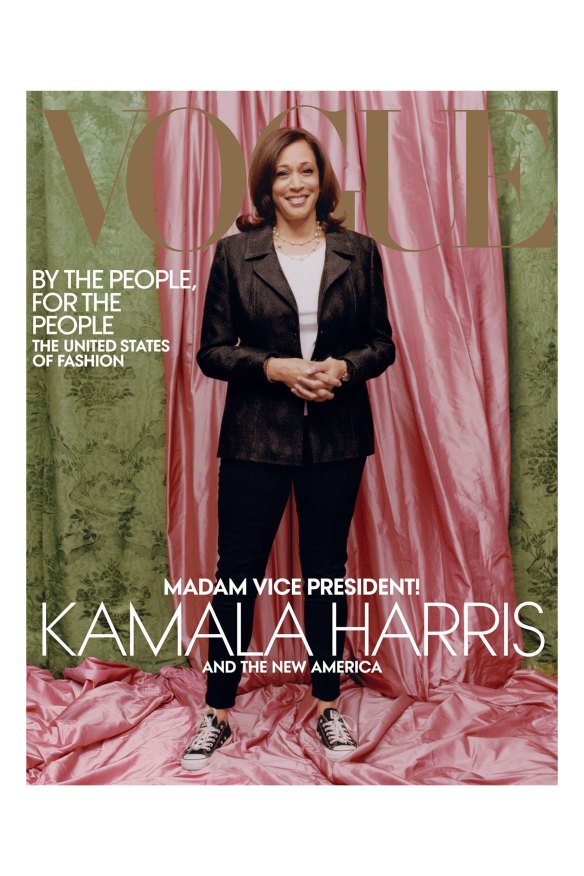
The Vogue cover that caused friction between the Harris and Biden camps.Credit: Google Image
During this unhappy phase, Harris grew frustrated that Biden’s inner circle did not do more to protect her. “They left her out to dry,” says Courtney Subramanian. “They didn’t help her in any way.” Dan Morain reckons there may have been “a Princess Diana issue”, because Harris brought “spark and style” to a somnolent White House occupied by a man of retirement age. “Without a doubt they underestimated her, they didn’t know what they had,” says Morain, before adding an important caveat: “I think Biden did.”
Their personal relationship is worth unpacking, for it goes a long way towards explaining why he eventually handed her the torch in a manner which prevented rivals vying for it. From his experience in the Obama administration, Biden knew what it felt like to be sneered at by senior West Wing aides. As a one-time understudy, he also understood the frustrations of the job. “Biden did not feel respected as Obama’s VP,” says Morain. “He went out of his way to make sure that didn’t happen to her.” It was not a father-daughter relationship, he says, but rather “a mentor-mentee relationship.”
Despite their 22-year age difference, they shared things in common. As California’s attorney-general, Harris had developed a close friendship with her counterpart in Delaware, Beau Biden, the president’s late son. Together, they had successfully taken on America’s major banks over their complicity in the 2008 financial crisis – another example of her humbling powerful men, this time the titans of Wall Street. Beau, like Harris’s beloved mother, Shyamala, had died of cancer. Biden had launched a “Cancer Moonshot” to prevent four million cancer deaths by mid-century. Shyamala’s academic mission had been to find a cure for breast cancer. Biden also never lost sight of the fact that Obama had favoured Hillary Clinton in 2016, when he, as vice president, harboured presidential aspirations of his own. It was a snub. Harris, he thought, deserved better treatment.
Harris’s aides speak of her vice presidency in terms of a clear timeline. Year one. Year two. Year three. One big shift came in the first half of year two. First, in April, she hired a new chief of staff, Lorraine Voles, a Washington veteran who had worked for Al Gore and Hillary Clinton. Instantly, this improved the channels of communication with the Biden high command, not least because Voles was a close colleague of the president’s chief of staff, Ron Klain. “They had to press the reset button,” says Courtney Subramanian.
‘Biden didn’t want to own the abortion issue. The White House realised we need to start lifting her up.’
Courtney Subramanian
Then, in June, came a more momentous turning point. The conservative-dominated Supreme Court overturned Roe v. Wade, the landmark 1973 ruling enshrining the nationwide right to abortion. When the court released its decision, Harris was mid-air on her way to Illinois. By strange coincidence, she was already due that Friday to deliver a speech at a YMCA in the suburbs of Chicago on improved healthcare for pregnant women. Quickly, she amended her remarks to reflect the gravity of the moment. “For nearly 50 years, we have talked about what Roe v. Wade protects,” she said. “Today, as of right now, as of this minute, we can only talk about what Roe v. Wade protected. Past tense. This is a healthcare crisis, because understand: millions of women in America will go to bed tonight without access to the healthcare and reproductive care that they had this morning.”
Initially, Harris had reservations about becoming the administration’s point woman on abortion, partly because she saw it as a “female issue” that risked defining her vice-presidency by her gender. Over the coming months, however, as conservative red states enacted laws banning the procedure and she heard first-hand harrowing stories from women denied access to abortion, hers became a clarion voice. For the Biden administration, the clarion voice. “Biden didn’t want to own the abortion issue,” says Courtney Subramanian. “The White House realised we need to start lifting her up.” The overturning of Roe v. Wade changed everything, reckons Dan Morain. “She got her footing.”
A nine-day trip to Africa in March 2023, Harris’ first visit to the continent since childhood, became another landmark event in her reputational rehabilitation. During a visit to Cape Coast Castle, a slave port in Ghana, she was shown the path enslaved men and women were forced to traipse before being shipped off to America in shackles. Visibly moved, she delivered unscripted remarks in which she embraced her racial heritage, a subject she had previously downplayed. “The horror of what happened here must always be remembered,” she said. “It cannot be denied. It must be taught. History must be learnt.”
Subramanian accompanied her on the trip. “She really hit her stride,” she says. “In terms of finding her footing, that was a good moment.”
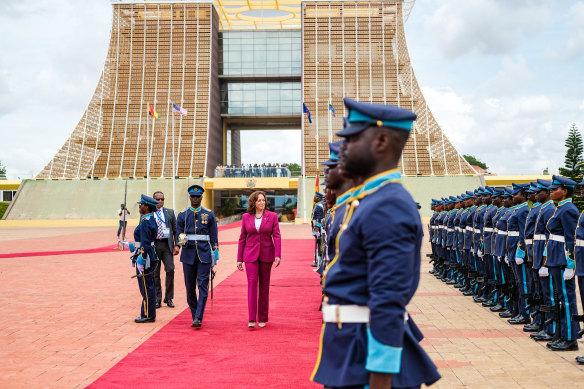
In Ghana, during a 2023 trip to Africa, Harris embraced her racial heritage instead of downplaying it.Credit: NYT
Away from the cameras, Harris made progress on another front, too. By now, the second gentleman, her husband Doug Emhoff – described by those who know him as like “a loveable golden retriever” – had struck up a friendship with the first lady, Jill Biden, another highly likeable individual. Their relationship became the balm needed to heal the scar tissue from Harris’s 2019 debate attack on Biden.
Jill Biden, though, remained her husband’s staunchest loyalist and was fully behind his decision, announced officially in the spring of 2023, to seek a second term as president. After the Democratic Party performed better than expected during the 2022 congressional midterm elections – partly because of Biden’s insistence that democracy itself was on the ballot – the octogenarian president no longer saw himself as a bridge to the next generation. Like a geriatric space cowboy, reaching shakily for his Aviator shades, he believed it was his patriotic duty to embark on one last mission. Harris would have to wait.
“You did such a great job,” cooed Jill Biden at a “Let’s Go Joe” rally immediately after the calamitous debate with Trump, addressing her husband as if he were in kindergarten. “You answered every question. You knew all the facts.” But even as she was speaking, Democrats were smashing the emergency glass.
Then came an interview – no, a moment – which altered the internal party debate. On CNN, the cable news channel that hosted the debate, the silver-haired anchor Anderson Cooper announced he was crossing to Harris and then bombarded her with questions, including: “Some within your party are wondering whether President Biden should step aside, what do you say to that?”
Harris replied assertively. “I’m not going to spend all night with you talking about the last 90 minutes when I’ve been watching the three-and-a-half years of performance … It was a slow start. That’s obvious to everyone. I’m not going to debate that point. I’m talking about the choice in November. I’m talking about one of the most important elections in our collective lifetime.“
Confronting what was unusually hostile questioning from a US anchor, Harris was commanding, loyal and, above all, unpanicked. Respect was due, not just for fronting up on primetime TV but for mounting a spirited rearguard. Handily, the setting for her interview – a warm-lit office bedecked with an Old Glory flag – looked presidential. More importantly, she sounded presidential. As the interview drew to an end, she also received a five-star review from CNN’s chief national correspondent, John King, famed for his election night touch-screen “magic map.” “Right there, feisty communicator, good on television,” he said, “and they kept her under wraps for three years.” That he described as “one of the greatest acts of political malpractice I have seen in my lifetime”. Perhaps it was time to look at Harris anew. On that fateful night, Harris was re-introducing herself to her party.
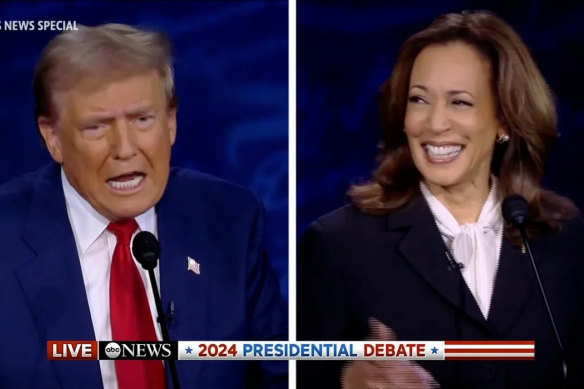
On the debate stage with Donald Trump, the first time the pair had come face-to-face.Credit: Google Image
Those midsummer weeks after the debate, as well as witnessing the first assassination attempt on Donald Trump, saw Joe Biden come under friendly fire from his own party. In The New York Times, the Hollywood star George Clooney penned an excoriating op-ed, declaring: “We are not going to win in November with this president.” Nancy Pelosi called for the president to make up his mind about seeking re-election, even though Biden had already written a letter to Democrats on Capitol Hill noting: “I am firmly committed to staying in this race, to running the race to the end, and to beating Donald Trump.”
Rival Democrats began making moves. Even as he publicly defended Biden, Gavin Newsom, an acolyte of Pelosi’s, was already setting up a shadow campaign. Influential figures, such as Barack Obama’s former communications guru, David Axelrod, talked up the prospect of a public nominating process if Biden stepped aside, which was shorthand for saying the party should not turn automatically to Harris. In this real-life game of thrones, Obama himself was thought to favour a selection process rather than a Harris coronation.
However, other senior black party figures, anxious that Harris would be sidelined, mobilised on her behalf. Foremost among them was the South Carolina congressman Jim Clyburn, whose endorsement of Biden during the 2020 primary race, after two humiliating defeats in Iowa and New Hampshire, saved his flatlining campaign. “I’m going to be for Harris if Biden ain’t there,” he told USA Today in June, a warning to his party not to bypass the black vice president.
Harris’ ascension to presidential candidate was ‘an overnight success 20 years in the making’, says one observer. ‘She’s always been underestimated.’
Working more quietly behind the scenes was a sisterhood of veteran female Democratic strategists, who call themselves “the Coloured Girls”. Among its black luminaries are Donna Brazile, who ran Al Gore’s presidential campaign in 2000, and Minyon Moore, who was Bill Clinton’s White House director of political affairs. They, too, were determined that a black woman should not be dissed and denied. Black women, after all, are the Democrats’ most loyal constituency. Bypassing Kamala Harris would mightily piss many off.
Partly in anticipation of this kind of crisis scenario, Harris staffers had for years compiled detailed spreadsheets listing key Democratic powerbrokers in each state and delegates attending the party’s national convention. Harris’ skills as a coalition-builder, which Doug Emhoff tells people is her political superpower, were also about to come to the fore. So when Biden finally called to say he was stepping aside, she was primed. For 10 hours, dressed in workout gear and a sweatshirt from her alma mater, Howard University, she hit the phones, racking up some 100 separate calls to key party figures.
Quickly, endorsements flooded in. Bill and Hillary Clinton rushed to support her. Congressman Jim Clyburn chimed in. By teatime, even Newsom was publicly in her camp. That evening, a member of “the Coloured Girls” convened a weekly “Win With Black Women” Zoom call. On a busy night, it attracted 1000 participants. Now, more than 80,000 women managed to connect. By the time she went to bed that night, Harris had created unstoppable momentum. The next day, even Pelosi gave her blessing. It was “an overnight success 20 years in the making”, says Dan Morain. “She’s always been underestimated.”
Instantly after becoming the de facto nominee, the messaging got better, especially her line that, as a former prosecutor used to taking on “predators”, “cheaters” and “fraudsters”, she knew “Donald Trump’s type”. Her choice of running mate, the folksy former high school football coach Tim Walz, was a hit. The Democratic convention in Chicago became a festival of Kamalamania. When Harris came face-to-face with Trump for the first time on the debate stage, she emerged from their 90-minute encounter the clear winner – and got the added bonus, minutes afterwards, of Taylor Swift’s endorsement. That night, in another illustration of her badass side, she revealed that she owns a gun – a pistol she keeps for personal safety. “If somebody breaks in my house,” she told Oprah Winfrey in September, “they’re getting shot.”
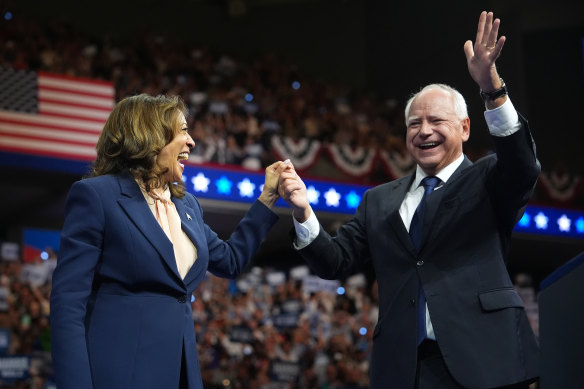
Harris’ running mate, Minnesota governor and former schoolteacher and football coach Tim Walz, is proving a hit.Credit: Getty Images
Not since the Obama years have Democrats been so joyous about their candidate. Maybe she was “the female Obama” after all. For at times it felt we were not only watching the transformation of Kamala Harris but her transfiguration.
Doubts persist. Harris mangled her first answer of the debate on the economy, an overriding issue for millions of voters. In trying to articulate what she would do on day one as president to relieve the cost-of-living crisis, she has regularly served up verbal tossed salads. Immigration, the second most salient issue for voters, remains a vulnerability. Even now, there are Democrats who fear the party is not fielding its strongest candidate – although a last-minute nominating contest, of the kind mooted by Obama and Pelosi, would have fractured the party.
In surveying her career, three through-lines emerge. A tendency to be underestimated. A habit of bettering ageing white men. And the simple fact that she has never been beaten in an election. For all that, the memory of her aborted run in 2020, when she started strongly but fell away, is impossible to erase. So, too, are foreboding electoral realities such as the fact that Pennsylvania, the pivotal state both candidates need to win, has never in its history elected a female governor or senator.
Harris’s mother, Shyamala, told her she was special and belonged in every room. As a black woman up against a racist misogynist, Kamala should also draw inspiration from those childhood tales of the Hindu goddess Kali, the warrior who slayed the demons.
To read more from Good Weekend magazine, visit our page at The Sydney Morning Herald, The Age and Brisbane Times.